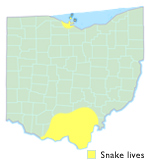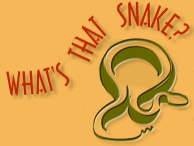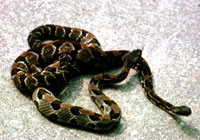WARNING!
The Eastern Timber Rattlesnake is a very venomous snake. It is highly dangerous to people and their pets. Its fangs are long enough to penetrate clothing and most boots. If you think one of these snakes has bitten someone, seek medical help immediately.
Latin name
Crotalus horridus
Fast facts
Appearance
The main or background color of the Eastern Timber Rattlesnake ranges from yellow to brown. A series of black or dark brown cross bands interrupts the background color. These bands sometimes are V-shaped. The tail is black, and there is a noticeable rattle at the end of the tail.
On some individuals very dark brown or black color hides most of the lighter background color. Sometimes, individuals are completely black. As with the other two venomous snakes in Ohio, the eyes of the Eastern Timber Rattlesnake have vertical pupils, while those of the non-venomous snakes have round pupils.
The color of the young is similar to that of the adults including the cross bands, except that the background color may be a lighter yellow. Also, the tail of a young Eastern Timber Rattlesnake often is banded instead of being solid black. In the very young the "rattle" consists of a single button at the end of the tail.
Range
Overall Range
The Eastern Timber Rattlesnake lives east of the Mississippi River in the northeastern states, except for the most northern parts including most of the Great Lakes Region.
Range in Ohio
In Ohio this snake occurs in several of the southern counties. Until the 1950s, when the last confirmed sightings were made, this snake lived on some of the islands of western Lake Erie and on nearby Catawba and Marblehead Peninsulas. Agricultural practices and urban development have caused this rattlesnake's range to shrink considerably.

Local Habitat
The Eastern Timber Rattlesnake lives in fairly remote and heavily wooded areas that are hilly. It often is associated with rock outcrops on hillsides.
Lifestyle
The Eastern Timber Rattlesnake is one of the most dangerous venomous snakes in northeastern United States. However, bites are not common. This snake normally is calm, preferring to stay coiled and motionless when approached, or to crawl away when bothered. If threatened though, the Eastern Timber Rattlesnake will rise up and shake its rattle, giving a threat or warning before striking. Generally, rattlesnakes can strike as much as 1/3 to 1/2 of their body length.
When born, the young rattlesnake has a single "button" at the end of its tail. As the snake grows it sheds its skin, thereby allowing for further growth in both length and girth. With each shed a new segment is added to the "rattle." Often, an older snake looses its original button through wear. The segments, usually more than five or six on a large adult, are loosely attached to each other. When the snake vibrates its tail these segments shake against one another, making the rattle sound. The noise is a very rapid, crisp, rattling vibration. Some people compare the sound to that made by certain nighttime insects. Others say it sounds like a vibration in dry leaves. The Eastern Timber Rattlesnake is diurnal in the spring and fall but it become nocturnal during the hot summer months. In the winter, it usually hibernates with a number of snakes, including such other species as the Black Rat Snake and the Northern Copperhead Snake.
More information

